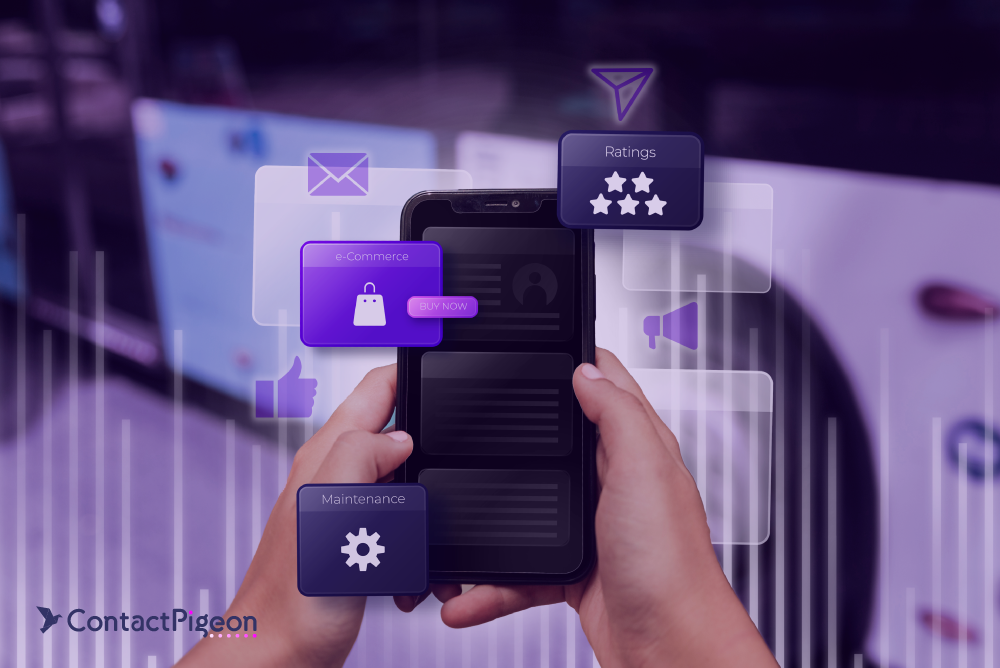What once began as casual digital window-shopping has evolved into a high-speed, hyper-personalized experience powered by intelligent systems. In 2025, AI commerce and AI chatbots in retail are transforming every stage of the shopper journey, from product discovery to post-purchase care, with business leaders reporting a 67% increase in sales from implementing AI agents and chatbots in eCommerce (Forbes).
No time to spare? Listen on the go!
What is AI commerce?

AI Commerce refers to the integration of artificial intelligence across digital retail operations to deliver data-driven, predictive, and hyper-personalized shopping experiences. It powers everything from dynamic pricing and inventory forecasting to intelligent search and recommendation engines, creating frictionless, conversion-optimized paths throughout the shopper journey.
How important is an AI chatbot in retail?
Unlike static, rule-based bots, AI chatbots in retail use machine learning and NLP to adapt, learn, and respond contextually. These intelligent agents handle complex product queries, resolve FAQs, personalize upsells, and offer 24/7 support, making them a cornerstone of any high-performance chatbot ecommerce strategy in 2025.
[Want to see how AI is driving higher loyalty and conversions? Read How AI Marketing is Revolutionizing Retail Customer Engagement.]
Key benefits of AI chatbots for eCommerce retailers and shoppers

AI chatbots have evolved from simple automation tools into high-impact assets that drive revenue, retention, and operational efficiency. For both retailers and consumers, the benefits are tangible: faster support, smarter product discovery, and more personalized experiences that convert. Below, we explore the key advantages that make AI chatbots indispensable in today’s digital retail environment.
- 24/7 instant support: AI chatbots provide round-the-clock assistance, resolving common questions, guiding product discovery, and handling order tracking, without human delay. This always-on service elevates convenience and builds shopper trust.
- Reduced cart abandonment: Chatbots re-engage hesitant buyers with timely nudges, personalized offers, and checkout support, helping recover lost revenue at a critical decision point in the shopper journey.
- Increased average order value (AOV): By analyzing behavior in real time, AI chatbots in retail can upsell or cross-sell complementary items, tailoring product suggestions to boost cart size naturally.
- Scalable customer service: Unlike human teams, AI chatbots can handle thousands of concurrent conversations, making them ideal for peak traffic periods without compromising service quality.
- Lower support costs: Automating repetitive queries and low-complexity tasks allows retailers to reduce staffing needs and reallocate resources to higher-impact CX functions, improving margins while enhancing support.
How AI chatbots influence each stage of the shopper journey
The modern shopper journey is fragmented across channels, devices, and touchpoints, and AI chatbots are uniquely positioned to bridge those gaps. By anticipating needs, automating key actions, and offering contextual assistance in real time, chatbots support shoppers at every stage: from exploration to conversion and beyond. Here’s how they map to, and enhance, each critical phase of the journey.
| Shopper Journey Stage | AI Chatbot Capabilities |
|---|---|
| Discovery & Product Exploration |
Personalized product recommendations Keyword-triggered responses Chat-to-browse interfaces |
| Consideration & Engagement |
FAQs, reviews, inventory checks AI chat as product expert Integration with live chat when needed |
| Purchase & Checkout |
Conversational checkout integrations (Shopify, WooCommerce) Secure payment handling Cart building inside the chat |
| Post-Purchase Engagement |
Order tracking Returns & exchange assistance Feedback collection |
From setup to scale: Best practices for AI chatbots in eCommerce
AI chatbots are only as effective as the strategy behind them. While the technology is powerful, success hinges on thoughtful implementation, continuous learning, and cross-channel integration. To unlock their full potential in eCommerce, brands must approach chatbot deployment with precision and purpose. Below are proven best practices that ensure your AI chatbot drives measurable impact from day one.
#1: Start with high-impact use cases
Begin with proven drivers of ROI such as abandoned cart recovery, personalized product recommendations, or automated answers to common pre-sale and support questions (e.g., shipping, sizing, and returns). These quick wins validate the chatbot’s value and create momentum across the shopper journey.
#2: Train with real customer data
Feed your AI chatbot with real-world inputs, like chat transcripts, customer reviews, behavioral logs, and transactional data. Include product SKUs, return/shipping policies, and visual assets like images to help the bot respond with accuracy and context. This equips the chatbot to speak your customer’s language while delivering relevant, data-informed responses.
#3: Ensure human escalation paths
Even the most advanced AI chatbot in retail can’t fully replace human intuition, especially in emotionally charged, high-stakes, or complex situations. To protect the customer experience, design intelligent escalation workflows that detect signals like customer frustration, repeat questions, or unclear intent. In these cases, the chatbot should immediately hand off to a live agent through a seamless transition, preserving chat history and context.
#4: Optimize for mobile & social channels
To future-proof your chatbot ecommerce strategy, deploy AI chatbots across mobile and social platforms like Instagram, Facebook Messenger, and WhatsApp. This ensures a consistent, real-time presence wherever your shoppers are active.
Optimizing the shopper journey with AI chatbots: A strategic guide for retail CMOs
For retail CMOs, implementing AI chatbots isn’t enough, it’s about using them strategically to elevate the entire customer experience. From operational integrations to customer-facing enhancements, every chatbot touchpoint should serve a clear purpose in the broader commerce strategy. This 10-point checklist outlines the most impactful applications of AI chatbots across the shopper journey, helping you prioritize what truly moves the needle.
| AI Chatbot Optimization Checklist | Impact on the Shopper Journey |
|---|---|
| 1. Integrate Real-Time Inventory Data | Enables instant availability checks and restock alerts during product exploration, reducing drop-off. |
| 2. Personalize Product Discovery Using Behavior-Based Triggers | Delivers tailored product suggestions based on browsing history, segment, and intent signals. |
| 3. Launch Conversational Abandoned Cart Recovery | Engages drop-offs with timely reminders, exclusive offers, and 1-click checkout inside the chat. |
| 4. Integrate Transactional Workflows (Orders, Returns, Shipping) | Automates order tracking, return processing, and shipping FAQs, reducing ticket volume and friction. |
| 5. Enable Voice-Activated Chatbots for Mobile CX | Enhances accessibility and speed on mobile, especially for voice-first segments like Gen Z. |
| 6. Use Chatbots to Promote Loyalty Rewards in Real Time | Notifies users of available points, exclusive perks, or personalized discounts at checkout. |
| 7. Deploy Multilingual AI Chatbots for Global Audiences | Supports cross-border commerce with real-time translation and localized UX. |
| 8. Connect AI Chatbots with Social Commerce Channels | Turns Instagram, WhatsApp, and Facebook Messenger into high-converting, conversational storefronts. |
| 9. Monitor Drop-Off Points in Chat Flows | Use analytics to identify where shoppers disengage, then fine-tune scripts and flows for higher retention. |
| 10. Test and Optimize Response Time, Tone, and Visuals | A/B test chatbot tone (formal vs. casual), visual assets, and response timing to maximize engagement. |
Common challenges and how to overcome them
Even the most promising AI chatbot strategies can fall short if critical challenges go unaddressed. Below are three common friction points in retail chatbot deployment, along with practical, high-impact solutions that ensure your AI delivers real value across the shopper journey.
| Challenge | What’s at stake | Solution |
|---|---|---|
| Misunderstanding Customer Intent | Shoppers often use vague or informal language, making it hard for bots to interpret what they want. If intent is misread, the conversation stalls and the shopper exits. | Train your chatbot using ecommerce-specific data sets, including past queries, search logs, and product-related language. Regular NLP tuning helps the bot respond more accurately in real time. |
| Poor User Experience (UX) | Complicated flows, dead ends, or robotic tone can frustrate users and cause them to abandon the chat, hurting conversion and brand perception. | Design clear conversation paths with visual buttons, smart prompts, and a natural tone. Include fallback options like “Talk to an expert” to keep users from hitting dead ends. |
| Integration Complexity | Without seamless integration into your tech stack, the chatbot can’t access product data, order info, or support history, limiting its usefulness. | Use middleware or chatbot platforms with built-in connectors for systems like Shopify, Magento, or your CRM. This enables live data access without heavy IT lift. |
Conversational commerce is the future
AI chatbots have moved beyond novelty, they’re now critical infrastructure in modern retail. From personalized product discovery to instant support and post-purchase care, chatbots are shaping every touchpoint of the shopper journey with intelligence, speed, and precision. Their ability to reduce friction, increase conversions, and scale service across channels gives retailers a decisive competitive edge. As consumer expectations grow for real-time, tailored experiences, brands that fail to adopt AI-powered commerce tools risk falling behind. In 2025, implementing a smart chatbot ecommerce strategy is all about delivering the kind of seamless, proactive service today’s shoppers demand.
See how your AI commerce strategy compares!
Book a free demo to explore best-in-class chatbot experiences with ContactPigeon.



